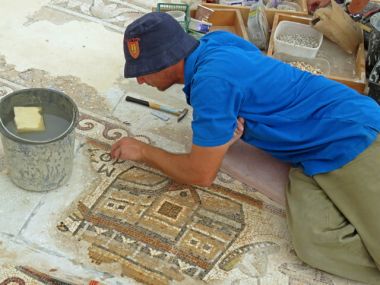Israel: After 1,500 years, rare Christian mosaic reveals ancient city plan

A 1,500-year-old Christian mosaic in Israel will be revealed to the public for the first time tomorrow.
The mosaic, depicting a map with streets and buildings, was exposed about two years ago in archaeological excavations the Israel Antiquities Authority conducted together with school children and employees from the Qiryat Gat Industrial Park.
It served as the floor of a church dating to the Byzantine period. The mosaic was removed from the site for conservation and was recently returned to its permanent location.
As well as animals such as a rooster, deer and birds and a special goblet with red fruits, the mosaic is believed to depict the Egyptian city of Chortaso, where Christian tradition holds that the prophet Habbakuk was buried. Archaeologists believe that the congregation might have come from the city and preserved its ground plan and images of its buildings in their church.
Sa'ar Ganor and Dr Rina Avner of the Israel Antiquities Authority said: "The appearance of buildings on mosaic floors is a rare phenomenon in Israel. The buildings are arranged along a main colonnaded street of a city, in a sort of ancient map."
Ganor said of the tiles or tesserae used for the mosaic: "The investment in the raw materials and their quality are the best ever discovered in Israel".
In another section of the mosaic, a Nile river landscape in Egypt consisting of a boat with a rolled-up sail, streets and buildings is depicted. The buildings are portrayed in detail and in three dimensions, and they have two or three storeys, balconies and galleries, roofs and windows.











